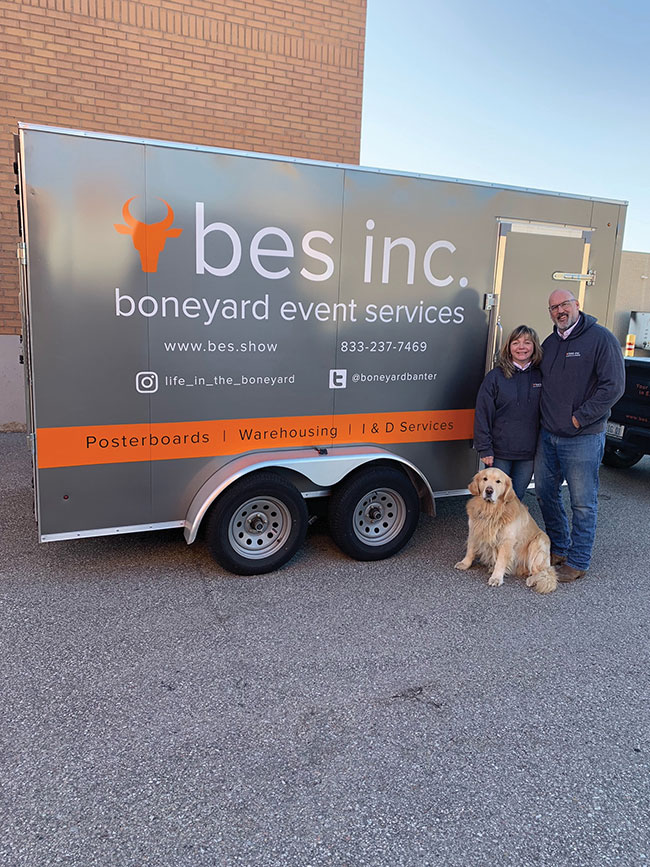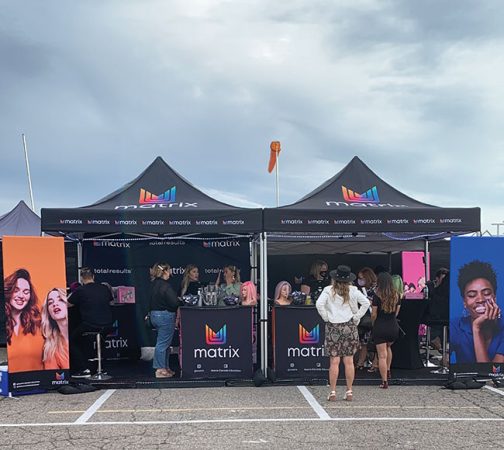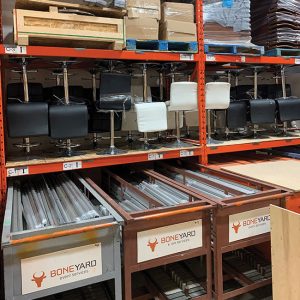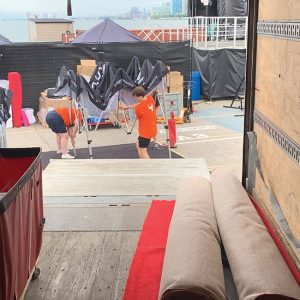
Whistling past the Boneyard – Boneyard Event Services, Mississauga, Ont.
By Treena Hein
Features Profiles Party and eventBuilding on past success, Boneyard Event Services plans for a strong 2022
 Boneyard Event Services president, Kevin LeGallais, vice-president, Rebecca LeGallais, and their shop dog Bodhi.
Boneyard Event Services president, Kevin LeGallais, vice-president, Rebecca LeGallais, and their shop dog Bodhi. It took perseverance, effort and lots of long days,” says Kevin LeGallais, of building his business Boneyard Event Services in Mississauga, Ont. in the early days.
“I was motivated because I saw a need to provide a better and more personal level of service to the industry. I relied on word of mouth and relationships and even to this day, extending relationships, being involved and looking for mutual connections are the main ways we find new business. Do a good job and do it at a fair price and people will tell their friends.”
Boneyard has worked to excel in the planning and execution of events through efficient communication, flexible offerings and friendly, professional staff. “Our training initiatives emphasize courtesy, helpfulness and responsiveness,” says LeGallais. “Shows can be stressful and overwhelming for many and we do everything we can to make the experience easy and hassle-free. A current project we are creating is a training resource package for new exhibitors looking to learn the ins and outs of face-to-face marketing.”
Boneyard services southwestern Ontario from Ottawa to Niagara Falls and over to Stratford and London with services ranging from installation/dismantling and rental of drape booths, hard wall system booths, aisle/booth carpeting, branded tents, logistics, graphic production, floor planning, poster boards and both standard and specialty furniture like benches and picnic tables. To deal with COVID, they now have on hand over 100 tabletop plexiglass guards, clear vinyl drapes and hand sanitizer dispenser stands for rent.
Shipping of equipment to smaller shows is done via company vehicles and rented trucks, with tractor trailers contracted for the larger shows. There are plans to build on their logistics services, and they have increased warehousing space from 10,000 square feet to 15,000.
Part time to business ownership
LeGallais got his start in the trade show industry in 1991. “I often call myself the accidental exhibitionist,” he says. “I was at Carleton University studying economics and got a part-time job for a local, family-run show services company. I guess I just had a knack for what it was about and I was a sucker for the long hours and dynamic nature of the job. It really is a different job every day and it keeps you on your toes to think your way through a problem and to understand the similarities of the craziness.”
After nine years in Ottawa, LeGallais went to GES to oversee their freight operations in Toronto. “I got the opportunity to switch sides of the industry and took a newly developed job for a UK-based show production company as their operations manager for the Toronto Home Show Group,” he remembers. “It gave me event management experience, to which my years as a supplier helped immensely. In 2006 I went out as an independent contractor overseeing trade and consumer show management. But as much as it was challenging and dynamic, I missed the intensity of being part of dozens of events a year in multiple industries. I had a friend and colleague starting up a company to produce his own events and was looking for a show services company. It was the gasoline on the fire I was starting to light. I agreed to service his events and the rest as they say is history.”
LeGallais describes his building his business as “bootstrapping it from the start.” “It’s probably the hardest way to start up but one that provides the greatest learning lessons,” he points out. “Like most rental companies, we fund everything up front and hope to get our money back eventually. We started slow as it takes time to get the opportunity to quote on events. I supplemented the rental side by event management contracts. Luckily I had lots of relationships in the industry and they helped me get to the decision makers. I also joined lots of chambers and associations that held annual events and we were able to get them to use us eventually.”
He also used a lot of subcontractors, freelancers and a small crew of part time labourers to get the ball rolling. He notes, however, that it’s tough to staff an event company at the best of times due to the infrequency and efforts needed. “At the beginning we did a lot of home shows and smaller community events,” he says. “They were the low-hanging fruit we needed to build our reputation as a service-oriented partner. Our portfolio of these types of events grew over the next few years. Eventually we started getting small conferences and trade shows and now we have a healthy mix of consumer and trade events. Today we still service many of the events that we started with but also large trade shows in multiple cities.” Competition hasn’t really changed much, he says. There have always been five other main competitors for Boneyard.
Equipment was stored in the back of the event venue run by the aforementioned colleague, and it was a big help financially but also came with a whole lot of handling. LeGallais built his own storage and shipping crates (not too pretty, he says, but they got the job done) and some are still in use today. (And if you’re wondering, the name Boneyard Event Services is a reference to the “boneyard,” the storage area on a show floor for the show services company and exhibitors. LeGallais is starting to transition the name to BES for a few different reasons, but he says “we know our roots will always be in the Boneyard.”)
With regards to equipment, there hasn’t been a big change in product range over the years, but LeGallais notes that as his company has grown, he’s definitely had to invest in more of it – more colour options and more professional options to service the trade industry versus the consumer events. For example, they re-designed the standard poster board setup to make them more suitable to smaller venues as well as being able to use them in closer proximity.
Before COVID, he had four full-time and about 20 part-time/casual staff, and when the pandemic hit, LeGallais had actually been poised to add two more full-time people due to being named the official show services company at the Western Fairgrounds in London, Ont. While it’s hard to recruit and retain, he’s connected with those who have show life in the blood like he does. “The best retention strategy is ensuring staff have what they need when they need it, making sure they feel appreciated and fostering a solid work-hard, play-hard philosophy,” LeGallais says. “Teamwork gets everyone through those long days and nights. When we find good staff, we always ask if they have any friends or siblings that are available to add to our roster.”

The Mississauga, Ont.,-based Boneyard Event Services offers a range of event-related services, from installation and dismantling to equipment rental to graphic production.
Looking forward
LeGallais and his team are constantly talking to industry contacts to build a consensus of what the future will hold in terms of safe and cost-effective event solutions. They predict staffing will be tough across the industry.
For his part, LeGallais may make some acquisitions. “And we continue to look to add unique options for rental,” he says. “The iPad kiosks we designed and promoted are a good example of that. They help our clients collect survey data in a professional way that also creates a sponsorship option to generate additional revenue. We’ve also acquired a large amount of equipment that we can use to design and install customized exhibits, which is an area we intend to market in aggressively as events return.”
LeGallais feels very confident in his future and that of the company, as well as in the return to live events. “The pandemic has caused us to rethink what we do and how we do it,” he says. “There will be new baselines that event producers will be looking for in their service providers and we feel that we’ll be able to meet those needs for them. I think between some generic growth, strategic partnerships, revised internal processes and some acquisition/expansion opportunities, we are in a good place.”
COVID has been devastating for the live events industry and both LeGallais and his wife picked up part time work where they could. Government support eventually came and although it helped, it didn’t cover everything. But they are optimistic about 2022. “There are lots of positive conversations beginning to happen throughout the industry and the fall 2021 saw some shows return,” says LeGallais. “And reports of a rebound in 2022 are all over the media. But much of this is out of our control and as much as we are planning every day and hopeful to be out on the show floors again, we know we may need to adapt some plans for the short term.”
“I think future opportunities for events lie in a hybrid event model, but not so much the virtual/in-person type,” he says. “Rather, there will be indoor/outdoor models. People need to gather in person. That’s where business happens and where relationships and memories are made. We think there’s good opportunity to expand our products and services to events that lend themselves to having an outdoor component.”
For more
Find Boneyard online at bes.show, on Instagram at Life_in_the_boneyard and on Twitter @Boneyardbanter.
Print this page

